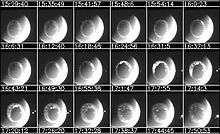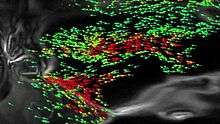Substorm


A substorm, sometimes referred to as a magnetospheric substorm or an auroral substorm, is a brief disturbance in the Earth's magnetosphere that causes energy to be released from the "tail" of the magnetosphere and injected into the high latitude ionosphere. Visually, a substorm is seen as a sudden brightening and increased movement of auroral arcs. Substorms were first described in qualitative terms by Kristian Birkeland[1] which he called polar elementary storms. Sydney Chapman used the term substorm about 1960 which is now the standard term. The morphology of aurora during of a substorm was first described by Syun-Ichi Akasofu in 1964[2][3] using data collected during the International Geophysical Year.
Substorms[4] are distinct from geomagnetic storms in that the latter take place over a period of several days, are observable from anywhere on Earth, inject a large number of ions into the outer radiation belt, and occur once or twice a month during the maximum of the solar cycle and a few times a year during solar minimum. Substorms, on the other hand, take place over a period of a few hours, are observable primarily at the polar regions, do not inject many particles into the radiation belt, and are relatively frequent — often occurring only a few hours apart from each other. Substorms can be more intense and occur more frequently during a geomagnetic storm when one substorm may start before the previous one has completed. The source of the magnetic disturbances observed at the Earth's surface during geomagnetic storms is the ring current, whereas the sources of magnetic disturbances observed on the ground during substorms are electric currents in the ionosphere at high latitudes.[5]
Substorms can cause magnetic field disturbances in the auroral zones up to a magnitude of 1000 nT, roughly 2% of the total magnetic field strength in that region. The disturbance is much greater in space, as some geosynchronous satellites have registered the magnetic field dropping to half of its normal strength during a substorm. The most visible indication of a substorm is an increase in the intensity and size of polar auroras.[5] Substorms can be divided into three phases: the growth phase, the expansion phase, and the recovery phase.[6]
In 2012, the THEMIS satellite mission observed the dynamics of rapidly developing substorms, confirming the existence of giant magnetic ropes and witnessed small explosions in the outskirts of Earth's magnetic field.[7]
References
- ↑ Birkeland, Kristian (1908 (section 1), 1913 (section 2)). The Norwegian Aurora Polaris Expedition 1902-1903. New York and Christiania (now Oslo): H. Aschehoug & Co. Check date values in:
|date=(help) out-of-print, full text online - ↑ Sarris, T. & Li, X. (30 March 2005). "Evolution of the dispersionless injection boundary associated with substorms" (PDF). Annales Geophysicae. 23: 877–884. Bibcode:2005AnGeo..23..877S. doi:10.5194/angeo-23-877-2005.
- ↑ Akasofu, S.-I. (April 1964). "The development of the auroral substorm". Planetary and Space Science. 12 (4): 273–282. Bibcode:1964P&SS...12..273A. doi:10.1016/0032-0633(64)90151-5.
- ↑ Potemra, T. (1991). Magnetospheric Substorms. Washington, D.C.: Am. Geophysical Union. p. 488. ISBN 0-87590-030-5.
- 1 2 Stern, David P. & Peredo, Mauricio (25 November 2001). "Substorms". Retrieved 21 March 2010.
- ↑ "Substorm". Southwest Research Institute. Retrieved 24 March 2010.
- ↑ NASA Spacecraft Make New Discoveries About Northern Lights http://www.nasa.gov/mission_pages/themis/auroras/northern_lights.html